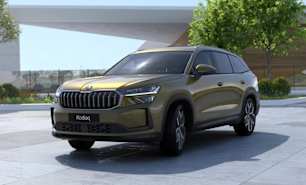Skoda claims the Kodiaq will accelerate from 0-100km/h in 7.9 seconds and while there’s enough power for overtaking and easy cruising, it’s no powerhouse.
Peak power of 140kW arrived high up in the rev range (4200–6500rpm) but maximum pulling power (320Nm) sits in a broad band from 1400–4100rpm, which is just where you want it around town and on the highway.
The seven-speed dual clutch auto delivers quick, smooth shifts and steering wheel paddles (standard on the Sportline) add extra involvement if you want or need to shift ratios yourself.
Suspension is by MacPherson-type struts at the front and multi-links at the rear, and ride comfort is good, with B-road imperfections and high-frequency bumps not upsetting the car unduly.
The combination of the Select’s 19-inch rims, shod with 235/50 Hankook Ventus S1 evo rubber, is comfy, although the Sportline on 20-inch alloys, wearing 235/45 Hankook Ventus evo SUV tyres, is much the same.
We drove a Sportline fitted with Dynamic Chassis Control (as part of the optional Ultimate Package) and in ‘Comfort’ the adaptive damping set-up is overly soft, to the point where the car lopes and feels floaty over undulating sections.
Switch to ‘Sport’ and it’s too firm on anything other than a billiard table smooth surface. Surprise, surprise, ‘Normal’ is the just-right Goldilocks setting.
Pushing a little harder through some back road corners, the AWD system with automatic torque distribution does its thing seamlessly, while the electrically assisted rack and pinion steering is nicely weighted and accurate with good feel.
What doesn’t always feel so good is the lane-keeping assist system making abrupt, intrusive corrections. Not all the time, but often enough to furrow your brow.
Braking is by discs all around, ventilated and clamped by dual-piston callipers at the front, and solid with single-piston sliding callipers at the rear. They proved progressive and strong over several hundred kilometres on the launch drive program.
Under the heading of miscellaneous observations, this car’s ergonomics are top-notch. All buttons, switches and controls are intuitive and easy to use.
The twisting column-mounted gear shift stalk, an increasingly popular placement, takes a bit of getting used to, but once you’re familiar it’s great.
A 12.0m turning circle is sizeable, even for a car of this size, and we noticed a distorted view from the reversing camera, especially when manoeuvring close to other cars.
The Kodiaq is impressively refined and quiet in terms of engine, tyre and wind noise.
The standard ‘Comfort’ seats are great, as are the Sportline’s grippier sports seats (and they’re still easy to get in and out of), while soft-touch materials around the dash and doors enhances the cabin’s premium feel.






.png)























.png)


















